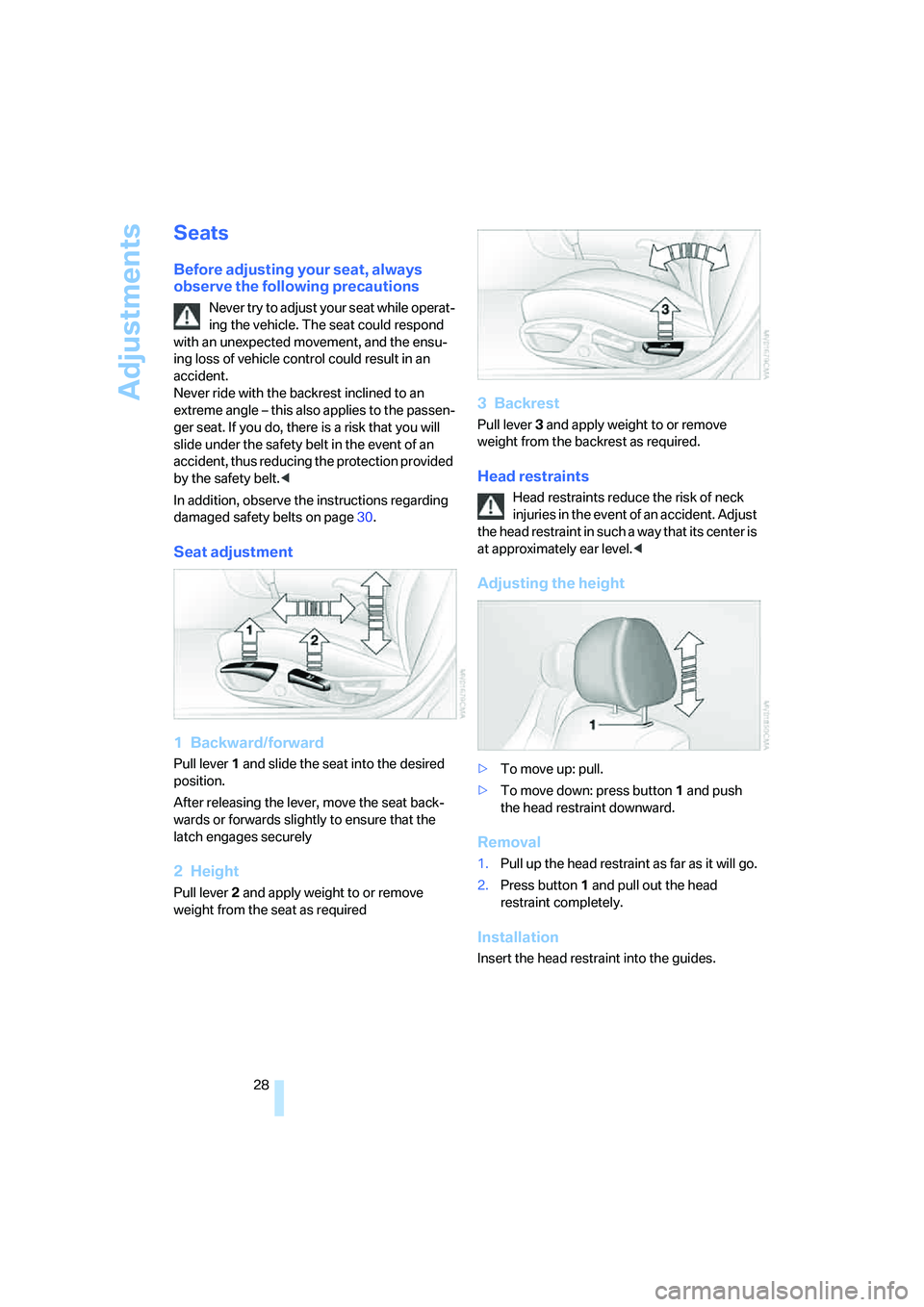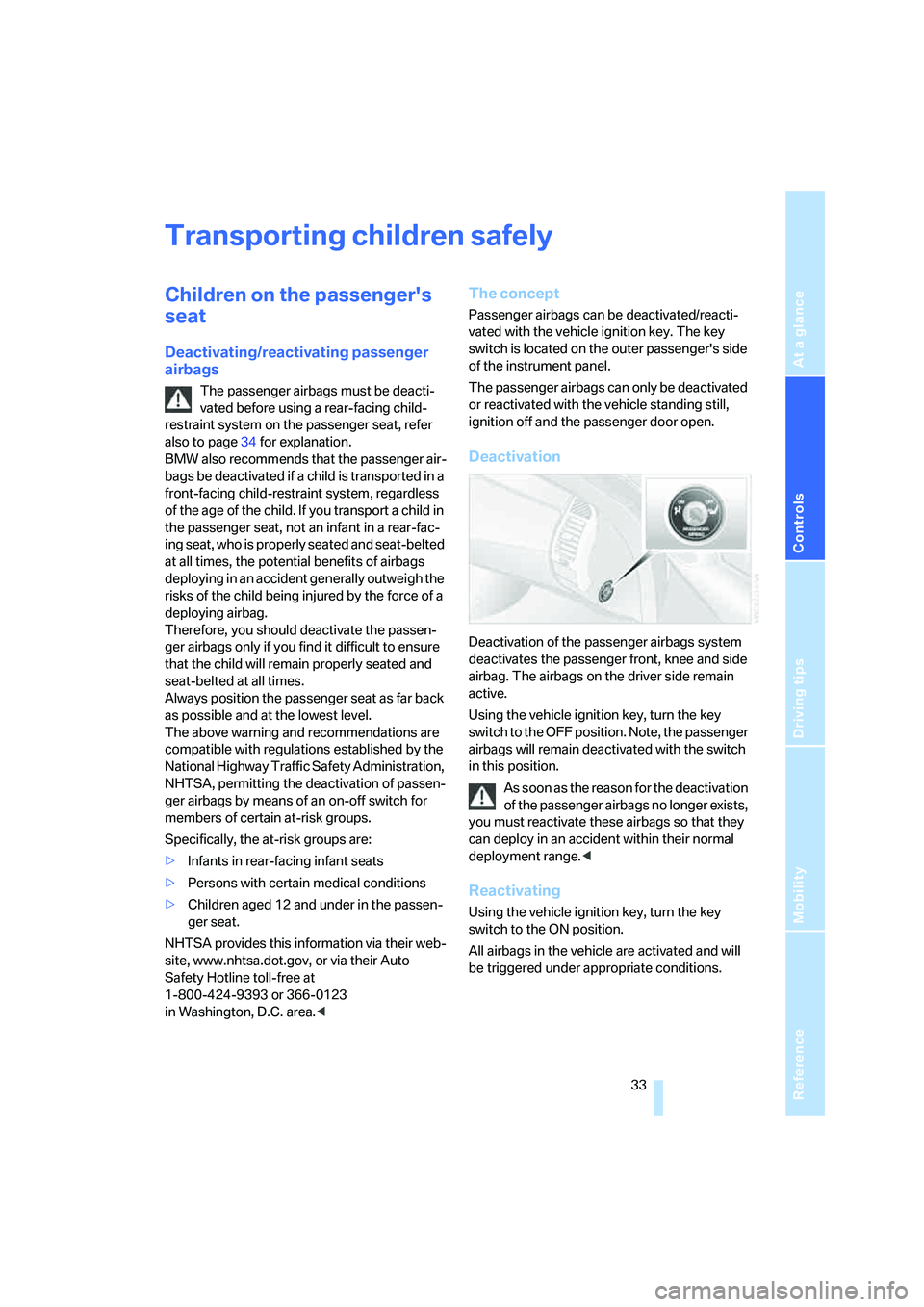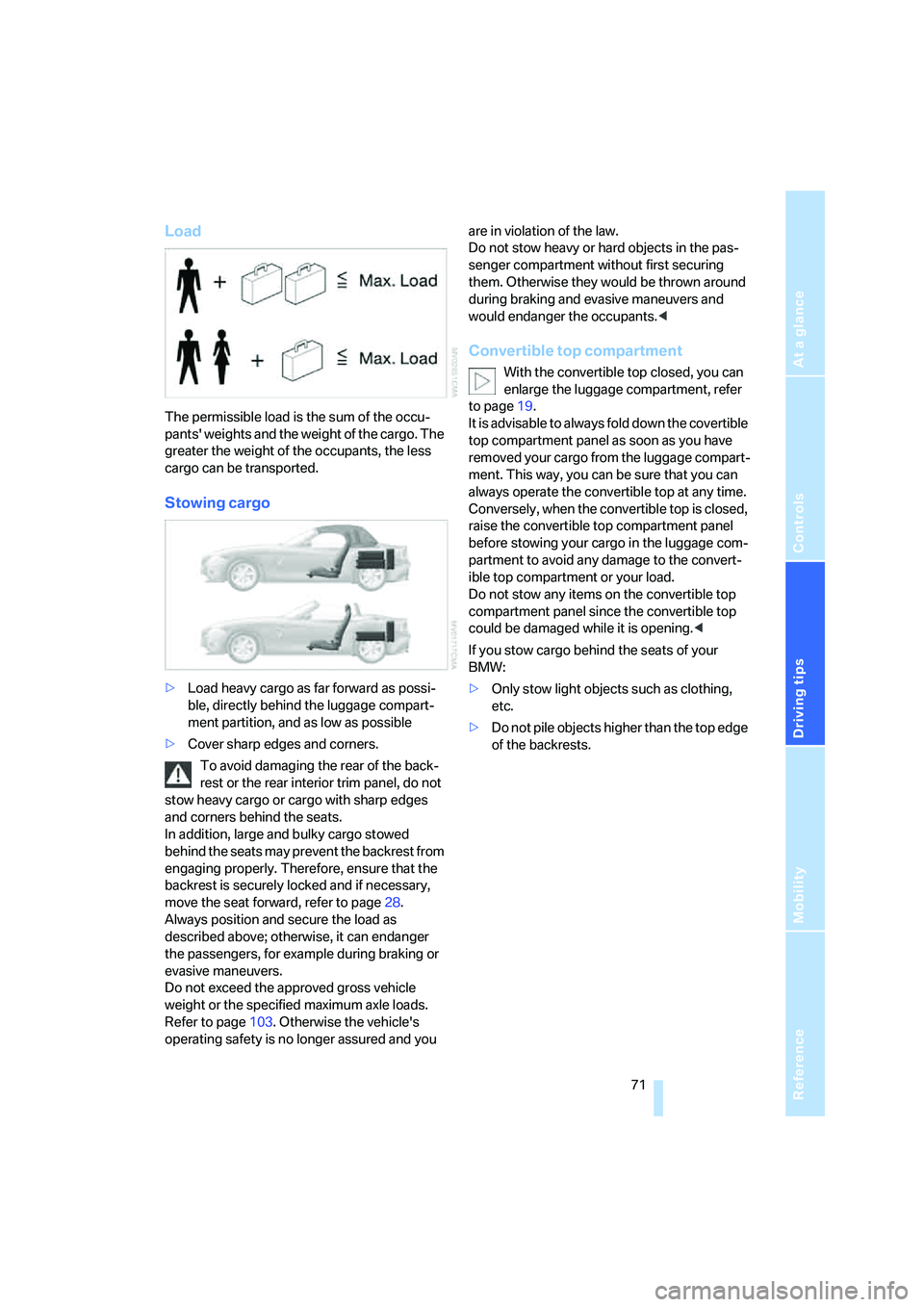2005 BMW Z4 2.5I seats
[x] Cancel search: seatsPage 30 of 120

Adjustments
28
Seats
Before adjusting your seat, always
observe the following precautions
Never try to adjust your seat while operat-
ing the vehicle. The seat could respond
with an unexpected movement, and the ensu-
ing loss of vehicle control could result in an
accident.
Never ride with the backrest inclined to an
extreme angle – this also applies to the passen-
ger seat. If you do, there is a risk that you will
slide under the safety belt in the event of an
accident, thus reducing the protection provided
by the safety belt.<
In addition, observe the instructions regarding
damaged safety belts on page30.
Seat adjustment
1 Backward/forward
Pull lever1 and slide the seat into the desired
position.
After releasing the lever, move the seat back-
wards or forwards slightly to ensure that the
latch engages securely
2Height
Pull lever 2 and apply weight to or remove
weight from the seat as required
3Backrest
Pull lever3 and apply weight to or remove
weight from the backrest as required.
Head restraints
Head restraints reduce the risk of neck
injuries in the event of an accident. Adjust
the head restraint in such a way that its center is
at approximately ear level.<
Adjusting the height
>To move up: pull.
>To move down: press button1 and push
the head restraint downward.
Removal
1.Pull up the head restraint as far as it will go.
2.Press button1 and pull out the head
restraint completely.
Installation
Insert the head restraint into the guides.
Page 35 of 120

Reference
At a glance
Controls
Driving tips
Mobility
33
Transporting children safely
Children on the passenger's
seat
Deactivating/reactivating passenger
airbags
The passenger airbags must be deacti-
vated before using a rear-facing child-
restraint system on the passenger seat, refer
also to page34 for explanation.
BMW also recommends that the passenger air-
bags be deactivated if a child is transported in a
front-facing child-restraint system, regardless
of the age of the child. If you transport a child in
the passenger seat, not an infant in a rear-fac-
ing seat, who is properly seated and seat-belted
at all times, the potential benefits of airbags
deploying in an accident generally outweigh the
risks of the child being injured by the force of a
deploying airbag.
Therefore, you should deactivate the passen-
ger airbags only if you find it difficult to ensure
that the child will remain properly seated and
seat-belted at all times.
Always position the passenger seat as far back
as possible and at the lowest level.
The above warning and recommendations are
compatible with regulations established by the
National Highway Traffic Safety Administration,
NHTSA, permitting the deactivation of passen-
ger airbags by means of an on-off switch for
members of certain at-risk groups.
Specifically, the at-risk groups are:
>Infants in rear-facing infant seats
>Persons with certain medical conditions
>Children aged 12 and under in the passen-
ger seat.
NHTSA provides this information via their web-
site, www.nhtsa.dot.gov, or via their Auto
Safety Hotline toll-free at
1-800-424-9393 or 366-0123
in Washington, D.C. area.<
The concept
Passenger airbags can be deactivated/reacti-
vated with the vehicle ignition key. The key
switch is located on the outer passenger's side
of the instrument panel.
The passenger airbags can only be deactivated
or reactivated with the vehicle standing still,
ignition off and the passenger door open.
Deactivation
Deactivation of the passenger airbags system
deactivates the passenger front, knee and side
airbag. The airbags on the driver side remain
active.
Using the vehicle ignition key, turn the key
switch to the OFF position. Note, the passenger
airbags will remain deactivated with the switch
in this position.
As soon as the reason for the deactivation
of the passenger airbags no longer exists,
you must reactivate these airbags so that they
can deploy in an accident within their normal
deployment range.<
Reactivating
Using the vehicle ignition key, turn the key
switch to the ON position.
All airbags in the vehicle are activated and will
be triggered under appropriate conditions.
Page 66 of 120

Interior conveniences
64
Interior conveniences
Glove compartment
To open
Press the two push buttons together.
To close
Swing the door up.
To prevent injury in the event of an acci-
dent, close the glove compartment
immediately after use.<
Storage compartments
Storage compartment between
backrests
To open
1.Press button; see arrow1
2.Swing the cover downward.
To close
Swing the door up.
Locking/unlocking
The storage compartment between the back-
rests is automatically locked and unlocked with
the central locking system.
Releasing manually
In the event of an electrical malfunction of the
central locking system, you can manually
unlock the storage compartment between the
seats.
1.Pull on the cord in the rear luggage com-
partment panel.
The storage compartment between the
seats unlocks
2.Press button; see arrow1.
Other compartments and nets*
You will find additional storage compartments
in the front doors and in the center console.
Depending on the particular version, the vehicle
may also be equipped with two storage com-
partments behind the seats.
A net
* is located on the passenger side along
the center console.
Beverage holder
A beverage holder is located on either side
beneath the air outlets.
Page 73 of 120

Reference
At a glance
Controls
Driving tips
Mobility
71
Load
The permissible load is the sum of the occu-
pants' weights and the weight of the cargo. The
greater the weight of the occupants, the less
cargo can be transported.
Stowing cargo
>Load heavy cargo as far forward as possi-
ble, directly behind the luggage compart-
ment partition, and as low as possible
>Cover sharp edges and corners.
To avoid damaging the rear of the back-
rest or the rear interior trim panel, do not
stow heavy cargo or cargo with sharp edges
and corners behind the seats.
In addition, large and bulky cargo stowed
behind the seats may prevent the backrest from
engaging properly. Therefore, ensure that the
backrest is securely locked and if necessary,
move the seat forward, refer to page28.
Always position and secure the load as
described above; otherwise, it can endanger
the passengers, for example during braking or
evasive maneuvers.
Do not exceed the approved gross vehicle
weight or the specified maximum axle loads.
Refer to page103. Otherwise the vehicle's
operating safety is no longer assured and you are in violation of the law.
Do not stow heavy or hard objects in the pas-
senger compartment without first securing
them. Otherwise they would be thrown around
during braking and evasive maneuvers and
would endanger the occupants.<
Convertible top compartment
With the convertible top closed, you can
enlarge the luggage compartment, refer
to page19.
It is advisable to always fold down the covertible
top compartment panel as soon as you have
removed your cargo from the luggage compart-
ment. This way, you can be sure that you can
always operate the convertible top at any time.
Conversely, when the convertible top is closed,
raise the convertible top compartment panel
before stowing your cargo in the luggage com-
partment to avoid any damage to the convert-
ible top compartment or your load.
Do not stow any items on the convertible top
compartment panel since the convertible top
could be damaged while it is opening.<
If you stow cargo behind the seats of your
BMW:
>Only stow light objects such as clothing,
etc.
>Do not pile objects higher than the top edge
of the backrests.
Page 112 of 120

Everything from A to Z
110 Floor mats, refer to the Caring
for your vehicle brochure
Fluid reservoir, washer
systems86
Fog lamps57
– indicator lamp13
Follow me home lamps56
Footbrake, refer to Driving
notes69
Front airbags53
Fuel
– average
consumption49
– display46
– quality76
– volume, refer to
Capacities105
Fuel display, refer to Fuel
gauge46
Fuel filler door76
– unlocking in case of
electrical fault76
Fuel reserve indicator, refer to
Fuel gauge46
Fuel tank capacity, refer to
Capacities105
Fuses95
G
Gasoline, refer to Fuel
quality76
Gasoline gauge, refer to Fuel
gauge46
Gear indicator
– for automatic transmission
with Steptronic38
– for sequential manual
gearbox SMG40
Gear lever
– automatic transmission with
Steptronic38
– manual transmission38
– sequential manual gearbox
SMG40Gear shifts
– via automatic transmission
with Steptronic38
– via sequential manual
gearbox SMG41
Glove compartment64
Gross weight, refer to
Weights103
H
Handbrake, refer to Parking
brake37
Hands-free microphone,
refer to Preparations for the
cellular phone65
Hands-free system65
Hardtop, refer to the separate
Owner's Manual
Hardtop preparation72
Hazard warning flashers10
Headlamp cover, care, refer to
the Caring for your vehicle
brochure
Headlamp flasher42
– indicator lamp13
Headlamps
– bulb replacement91
– care, refer to the Caring for
your vehicle brochure
– cleaning43
Headlamps, automatic
control56
Headlamp washer
reservoir86
– volume, refer to
Capacities105
Headlamp washer
system
– cleaning the headlamps43
– washing fluids86
Head restraints28
Heated mirrors31
Heated seats30
Heating58
– exterior mirrors31
– rear window59,63
– seats30Heavy loads, refer to Stowing
cargo71
Height, refer to
Dimensions104
Height adjustment
– seats28
– steering wheel31
High beams57
– bulb replacement92
– headlamp flasher42
– indicator lamp13
High Performance
Synthetic Oil87
– alternative oils87
– approved oils87
Holders for beverages64
Hood84
Horn10
Hot exhaust system69
Hydraulic Brake Assistant,
refer to Dynamic Brake
Control DBC50
Hydraulics, brake88
Hydroplaning69
I
Ice warning48
Identification mark
– Run Flat tires82
– tire coding80
Ignition36
Ignition key16
Ignition lock36
Imprint2
Inclines69
Index106
Page 115 of 120

Reference
At a glance
Controls
Driving tips
Mobility
113
Plastic, refer to the Caring for
your vehicle brochure
Pollen, refer to
– Microfilter59
– Microfilter/activated-
charcoal filter63
Power convertible top21
Power loss
– electric power windows20
Power output, refer to Engine
data102
Power seat29
Power socket65
Power steering, electric42
Power supply interruption
– battery95
Power windows
– initializing20
Power windows protective
function, refer to Trap
protection20
Preparations for the cellular
phone65
Pressure, tires78
Pressure monitoring, tires,
refer to Flat Tire Monitor52
R
Radio, refer to the Owner's
Manual for Radio
Radio navigation, refer to the
separate Owner's Manual
Radio remote control key,
refer to Master keys with
remote control16
Rain sensor43
Reading lamps57
Rear lamps
– bulb replacement93
– indicator lamp, defective
lamp13
Rearview mirror31
Rear window defroster
– air conditioning59
– automatic climate control63
Recirculated air mode
– air conditioning59
– automatic climate control62Recirculating the air, refer to
Recirculated air
mode59,62
Reclining seat, refer to
Seats28
Refueling76
– fuel filler door76
Releasing
– hood84
Remaining distance, refer to
Range49
Remaining distance to next
service47
Remote control16
– luggage compartment lid17
– malfunction17
Replacement key16
Replacement key, refer to
New keys16
Replacement of tires82
– changing a wheel94
– new wheels and tires82
Replacing lamps, refer to
Lamps and bulbs91
Restraint systems
– for children35
– refer to Safety belts30
Reverse
– automatic transmission with
Steptronic39
– manual transmission38
Reverse gear
– sequential manual gearbox
SMG40
Rod antenna, refer to the
Caring for your vehicle
brochure
Rope, refer to Towing and
tow-starting98
RSC Runflat System
Component, refer to Run
Flat tires82
Rubber parts, refer to the
Caring for your vehicle
brochure
Runflat System Component
RSC, refer to Run Flat
tires
82Run Flat tires82
– changing a tire81,82
– changing a wheel94
– flat tire53
– tire inflation pressure78
– winter tires82
S
Safe seating position27
– with airbags27
– with safety belts27
Safety belts30
– care, refer to the Caring for
your vehicle brochure
– safe seating position27
– warning lamp12,30
Safety systems, refer to
– Airbags53
– Antilock Brake System
ABS50
– Dynamic Stability Control
DSC50
Safety tires, refer to Run Flat
tires82
Screwdriver, refer to Onboard
tool kit91
Seat adjustment28
– mechanical28
– M Sports seat29
– power29
Seat heating30
Seat memory29
Seat position, storing29
Seats28
– adjusting the sports seat29
– heating30
– memory, refer to Seat
memory29
– power adjustment29
– safe seating position27
– storing positions29
Securing, locking the vehicle
– from inside18
– from outside17
Securing loads,
refer to Cargo loading71